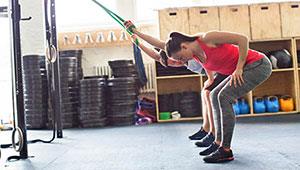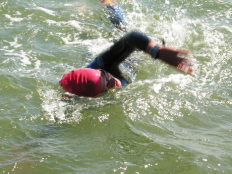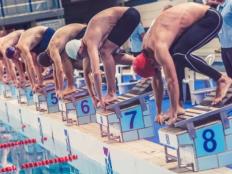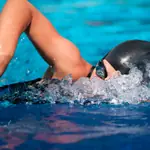When reaching do not let your hips drop. A level body is a fast body. Hips that drop in the water cause drag. Drag slows you down and makes you work harder.
Imagine swimming downhill. Picture a line across your chest from shoulder to shoulder. Then picture a line from throat straight down the midline of your torso. Where those two lines intersect is called the T-spot. Lean down on the T-spot while swimming. Your body is a seesaw in the water and lowering one end will raise the other.
When rotating, you should be as tough as if on a spit. No side-to-side movement at all. Imagine a line from the top of your head to inside the tips of your big toes and you may only rotate on that center line. That rotation should be driven from your hips. Much like a boxer can get a snap on his or her punch with a twist of the torso and a batter can drive the ball farther by opening up their hips to the pitch, an open-water distance swimmer should be driving their strokes with hip rotation. Your reach is dictated by the power of your hip twist (to not quite 90 degrees). You will feel this focus in your obliques.
Reach Drills
Stroke Count: Swim 25 yards normally counting each stroke. One full stroke goes from the front of the reach to front of reach with same hand. Begin trying to drop the count by one or two strokes each 25 by lengthening your reach. Usain Bolt, the greatest sprinter in history, takes 41 steps over 100m. Everyone else takes 44. Same concept.
Catch-up Drill: Swim normally, but do not start the next pull phase until the previous pull phase is finished. Which means pull, wait for the recovery to finish, touch the leading hand with the recovering hand, and begin the next pull. You'll feel like you're sinking at first but you'll get better. Remember to press down on the T-spot.
Sideline Kick: Lay on your side in the water as though you are mid-stroke—one arm straight out in front, one at your side, shoulders perpendicular to the pool bottom, head looking down, neck relaxed. Basically, the position you're in right before the recovery phase of the stroke. Kick across the pool with short, quick flutter kicks. This isolates the kick, is better for you than using a kick board, and teaches your body to balance in the water in the reach position. Do 5 sets of 50 yards. Be sure you are always facing the same wall no matter which direction you are going so that you work both sides.
More: Try the Side-Aligned Balance Drill
Pull
The pull begins with the catch. Doubling up on the above picture, look at Yang's pulling arm. Notice how high his elbow is. The elbow should always be higher than the hand during the catch phase of a stroke. Reach. Anchor your hand vertically, grabbing the water. Lever your body over your hand, digging deeply into the water with your elbow high, thus allowing you to pull using your whole forearm and hand. Allow your hand to make a small S under the water. It should not cross your body's center line. Be sure your hand is cupped, as though holding water to drink. Open fingers let water through.
The key to the pull is the high elbow. Many swimmers let the elbow drop, which makes the whole arm slip through the water. Try one of these visualization techniques:
A) You are climbing through the water. The water is solid and you anchor your hand and pull yourself over your hand as though climbing a wall.
B) There is a barrel underneath you so your elbow has to be high because you are wrapping your arm around the barrel, swimming over it.
There should be force in the pull; do not let yourself slip through the water. You are grabbing water and pushing it towards your feet. Mr. Newton says that pushing water behind you will move you in the opposite direction. Splashing side to side means you are moving laterally rather than forward, wasting energy. As you pull, use your hips to power the rotation into your reach.
- 2
- of
- 3
Get ACTIVE on the Go


Meet Mobile
Swim smarter: heats, lane assignments and real-time results in the palm of your hand.
Available for iOS | Android







Discuss This Article